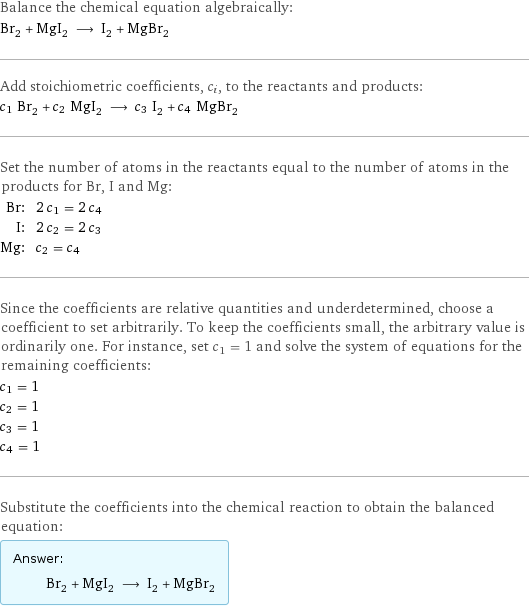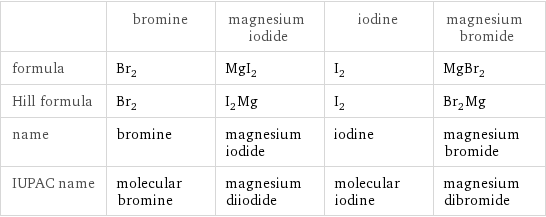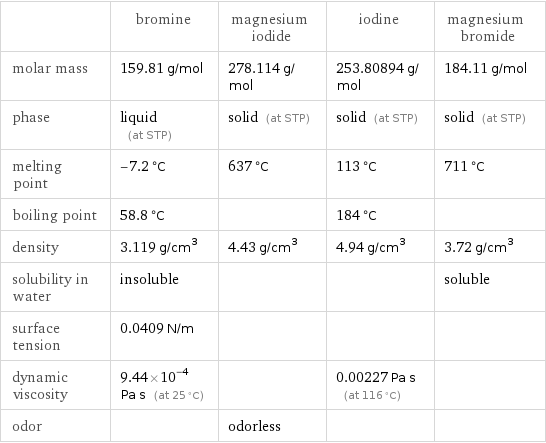Input interpretation

Br_2 bromine + MgI_2 magnesium iodide ⟶ I_2 iodine + MgBr_2 magnesium bromide
Balanced equation

Balance the chemical equation algebraically: Br_2 + MgI_2 ⟶ I_2 + MgBr_2 Add stoichiometric coefficients, c_i, to the reactants and products: c_1 Br_2 + c_2 MgI_2 ⟶ c_3 I_2 + c_4 MgBr_2 Set the number of atoms in the reactants equal to the number of atoms in the products for Br, I and Mg: Br: | 2 c_1 = 2 c_4 I: | 2 c_2 = 2 c_3 Mg: | c_2 = c_4 Since the coefficients are relative quantities and underdetermined, choose a coefficient to set arbitrarily. To keep the coefficients small, the arbitrary value is ordinarily one. For instance, set c_1 = 1 and solve the system of equations for the remaining coefficients: c_1 = 1 c_2 = 1 c_3 = 1 c_4 = 1 Substitute the coefficients into the chemical reaction to obtain the balanced equation: Answer: | | Br_2 + MgI_2 ⟶ I_2 + MgBr_2
Structures

+ ⟶ +
Names

bromine + magnesium iodide ⟶ iodine + magnesium bromide
Equilibrium constant
![Construct the equilibrium constant, K, expression for: Br_2 + MgI_2 ⟶ I_2 + MgBr_2 Plan: • Balance the chemical equation. • Determine the stoichiometric numbers. • Assemble the activity expression for each chemical species. • Use the activity expressions to build the equilibrium constant expression. Write the balanced chemical equation: Br_2 + MgI_2 ⟶ I_2 + MgBr_2 Assign stoichiometric numbers, ν_i, using the stoichiometric coefficients, c_i, from the balanced chemical equation in the following manner: ν_i = -c_i for reactants and ν_i = c_i for products: chemical species | c_i | ν_i Br_2 | 1 | -1 MgI_2 | 1 | -1 I_2 | 1 | 1 MgBr_2 | 1 | 1 Assemble the activity expressions accounting for the state of matter and ν_i: chemical species | c_i | ν_i | activity expression Br_2 | 1 | -1 | ([Br2])^(-1) MgI_2 | 1 | -1 | ([MgI2])^(-1) I_2 | 1 | 1 | [I2] MgBr_2 | 1 | 1 | [MgBr2] The equilibrium constant symbol in the concentration basis is: K_c Mulitply the activity expressions to arrive at the K_c expression: Answer: | | K_c = ([Br2])^(-1) ([MgI2])^(-1) [I2] [MgBr2] = ([I2] [MgBr2])/([Br2] [MgI2])](../image_source/ad017a57cfba30cb05307afe70237b47.png)
Construct the equilibrium constant, K, expression for: Br_2 + MgI_2 ⟶ I_2 + MgBr_2 Plan: • Balance the chemical equation. • Determine the stoichiometric numbers. • Assemble the activity expression for each chemical species. • Use the activity expressions to build the equilibrium constant expression. Write the balanced chemical equation: Br_2 + MgI_2 ⟶ I_2 + MgBr_2 Assign stoichiometric numbers, ν_i, using the stoichiometric coefficients, c_i, from the balanced chemical equation in the following manner: ν_i = -c_i for reactants and ν_i = c_i for products: chemical species | c_i | ν_i Br_2 | 1 | -1 MgI_2 | 1 | -1 I_2 | 1 | 1 MgBr_2 | 1 | 1 Assemble the activity expressions accounting for the state of matter and ν_i: chemical species | c_i | ν_i | activity expression Br_2 | 1 | -1 | ([Br2])^(-1) MgI_2 | 1 | -1 | ([MgI2])^(-1) I_2 | 1 | 1 | [I2] MgBr_2 | 1 | 1 | [MgBr2] The equilibrium constant symbol in the concentration basis is: K_c Mulitply the activity expressions to arrive at the K_c expression: Answer: | | K_c = ([Br2])^(-1) ([MgI2])^(-1) [I2] [MgBr2] = ([I2] [MgBr2])/([Br2] [MgI2])
Rate of reaction
![Construct the rate of reaction expression for: Br_2 + MgI_2 ⟶ I_2 + MgBr_2 Plan: • Balance the chemical equation. • Determine the stoichiometric numbers. • Assemble the rate term for each chemical species. • Write the rate of reaction expression. Write the balanced chemical equation: Br_2 + MgI_2 ⟶ I_2 + MgBr_2 Assign stoichiometric numbers, ν_i, using the stoichiometric coefficients, c_i, from the balanced chemical equation in the following manner: ν_i = -c_i for reactants and ν_i = c_i for products: chemical species | c_i | ν_i Br_2 | 1 | -1 MgI_2 | 1 | -1 I_2 | 1 | 1 MgBr_2 | 1 | 1 The rate term for each chemical species, B_i, is 1/ν_i(Δ[B_i])/(Δt) where [B_i] is the amount concentration and t is time: chemical species | c_i | ν_i | rate term Br_2 | 1 | -1 | -(Δ[Br2])/(Δt) MgI_2 | 1 | -1 | -(Δ[MgI2])/(Δt) I_2 | 1 | 1 | (Δ[I2])/(Δt) MgBr_2 | 1 | 1 | (Δ[MgBr2])/(Δt) (for infinitesimal rate of change, replace Δ with d) Set the rate terms equal to each other to arrive at the rate expression: Answer: | | rate = -(Δ[Br2])/(Δt) = -(Δ[MgI2])/(Δt) = (Δ[I2])/(Δt) = (Δ[MgBr2])/(Δt) (assuming constant volume and no accumulation of intermediates or side products)](../image_source/e0db57806a1b14f6fedce2f001ed6879.png)
Construct the rate of reaction expression for: Br_2 + MgI_2 ⟶ I_2 + MgBr_2 Plan: • Balance the chemical equation. • Determine the stoichiometric numbers. • Assemble the rate term for each chemical species. • Write the rate of reaction expression. Write the balanced chemical equation: Br_2 + MgI_2 ⟶ I_2 + MgBr_2 Assign stoichiometric numbers, ν_i, using the stoichiometric coefficients, c_i, from the balanced chemical equation in the following manner: ν_i = -c_i for reactants and ν_i = c_i for products: chemical species | c_i | ν_i Br_2 | 1 | -1 MgI_2 | 1 | -1 I_2 | 1 | 1 MgBr_2 | 1 | 1 The rate term for each chemical species, B_i, is 1/ν_i(Δ[B_i])/(Δt) where [B_i] is the amount concentration and t is time: chemical species | c_i | ν_i | rate term Br_2 | 1 | -1 | -(Δ[Br2])/(Δt) MgI_2 | 1 | -1 | -(Δ[MgI2])/(Δt) I_2 | 1 | 1 | (Δ[I2])/(Δt) MgBr_2 | 1 | 1 | (Δ[MgBr2])/(Δt) (for infinitesimal rate of change, replace Δ with d) Set the rate terms equal to each other to arrive at the rate expression: Answer: | | rate = -(Δ[Br2])/(Δt) = -(Δ[MgI2])/(Δt) = (Δ[I2])/(Δt) = (Δ[MgBr2])/(Δt) (assuming constant volume and no accumulation of intermediates or side products)
Chemical names and formulas

| bromine | magnesium iodide | iodine | magnesium bromide formula | Br_2 | MgI_2 | I_2 | MgBr_2 Hill formula | Br_2 | I_2Mg | I_2 | Br_2Mg name | bromine | magnesium iodide | iodine | magnesium bromide IUPAC name | molecular bromine | magnesium diiodide | molecular iodine | magnesium dibromide
Substance properties

| bromine | magnesium iodide | iodine | magnesium bromide molar mass | 159.81 g/mol | 278.114 g/mol | 253.80894 g/mol | 184.11 g/mol phase | liquid (at STP) | solid (at STP) | solid (at STP) | solid (at STP) melting point | -7.2 °C | 637 °C | 113 °C | 711 °C boiling point | 58.8 °C | | 184 °C | density | 3.119 g/cm^3 | 4.43 g/cm^3 | 4.94 g/cm^3 | 3.72 g/cm^3 solubility in water | insoluble | | | soluble surface tension | 0.0409 N/m | | | dynamic viscosity | 9.44×10^-4 Pa s (at 25 °C) | | 0.00227 Pa s (at 116 °C) | odor | | odorless | |
Units
